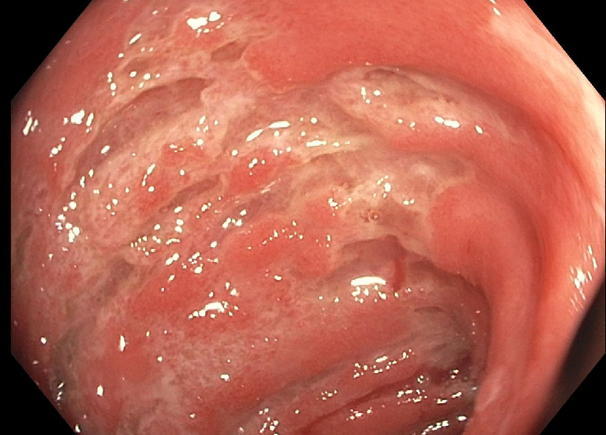Tuesday Poster Session
Category: Small Intestine
P6227 - Mycophenolate Mofetil-Induced Ileitis and Colitis Following Chemotherapy
Tuesday, October 28, 2025
10:30 AM - 4:00 PM PDT
Location: Exhibit Hall

Melanie L. Wiseman, MD (she/her/hers)
Naval Medical Center San Diego
San Diego, CA
Presenting Author(s)
Melanie L. Wiseman, MD, Byung L. Lee, MD, Brett L. Sadowski, MD
Naval Medical Center San Diego, San Diego, CA
Introduction: Mycophenolate Mofetil (MMF) is an immunosuppressant commonly administered for autoimmune diseases and solid organ transplants. While gastrointestinal side effects from the medication, including diarrhea, are common, MMF-induced colitis is a rare adverse effect seen in less than 10% of patients. MMF-induced ileitis is rarer than colitis, occurring in less than 1% of patients.
Case Description/
Methods: A 53-year-old female with kidney transplants in 1994 and 2004 on tacrolimus, MMF, and prednisone as well as recent diagnosis of Stage II colon adenocarcinoma status post right hemicolectomy with end-side anastomosis, presented with severe watery diarrhea leading to significant acute kidney injury (AKI). Symptoms began following cycle three of adjuvant Capecitabine and Oxaliplatin (CAPOX) therapy. GI PCR to include C. difficile testing was negative. She experienced more mild symptoms after her first two cycles of CAPOX treatment that self-resolved after 2-4 days. Given severity of diarrhea ( >10 BMs/day, resulting in severe AKI), persistency (diarrhea continuing 20 days after cycle 3) in an immunocompromised patient, colonoscopy was done. Endoscopic evaluation showed neo-terminal ileum with severe circumferential edema, erythema, and deep cratered ulcers (Figure 1) and diffuse edema and erythema in the colon without colonic erosions or ulcerations. Findings were initially concerning for Cytomegalovirus (CMV) enteritis and colitis in an immunocompromised patient and empiric antiviral treatment with ganciclovir was administered. However, pathology review was negative for viral inclusions and CMV stain and showed severely ulcerated enteritis with increased lamina propria eosinophils and mild active colitis with increased crypt apoptosis and mild architectural distortion (Figure 2), consistent with drug-induced injury from MMF. Patient’s MMF was stopped and patient’s diarrhea and AKI resolved.
Discussion: This case highlights a unique presentation of MMF-induced ileitis and colitis in a patient with surgically-altered anatomy. It illustrates the diagnostic dilemma that can occur between CMV and MMF-induced enteritis/colitis in a person on immunosuppression as well as endoscopic appearance similarities which require a histologic evaluation. MMF-induced enteritis/colitis should still be considered in the differential despite a patient being on the medication for more than 20 years. Management is largely supportive after cessation of the drug and typically patients respond in days to weeks.

Figure: Figure 1. Endoscopic image of the neo-terminal ileum with severe circumferential edema, erythema, and deep cratered ulcers.

Figure: Figure 2. Pathology image (low power view) of colonic biopsy showing architectural disturbance with irregularly-shaped crypts and focal crypt drop-out (H&E, 40x).
Disclosures:
Melanie Wiseman indicated no relevant financial relationships.
Byung Lee indicated no relevant financial relationships.
Brett Sadowski indicated no relevant financial relationships.
Melanie L. Wiseman, MD, Byung L. Lee, MD, Brett L. Sadowski, MD. P6227 - Mycophenolate Mofetil-Induced Ileitis and Colitis Following Chemotherapy, ACG 2025 Annual Scientific Meeting Abstracts. Phoenix, AZ: American College of Gastroenterology.
Naval Medical Center San Diego, San Diego, CA
Introduction: Mycophenolate Mofetil (MMF) is an immunosuppressant commonly administered for autoimmune diseases and solid organ transplants. While gastrointestinal side effects from the medication, including diarrhea, are common, MMF-induced colitis is a rare adverse effect seen in less than 10% of patients. MMF-induced ileitis is rarer than colitis, occurring in less than 1% of patients.
Case Description/
Methods: A 53-year-old female with kidney transplants in 1994 and 2004 on tacrolimus, MMF, and prednisone as well as recent diagnosis of Stage II colon adenocarcinoma status post right hemicolectomy with end-side anastomosis, presented with severe watery diarrhea leading to significant acute kidney injury (AKI). Symptoms began following cycle three of adjuvant Capecitabine and Oxaliplatin (CAPOX) therapy. GI PCR to include C. difficile testing was negative. She experienced more mild symptoms after her first two cycles of CAPOX treatment that self-resolved after 2-4 days. Given severity of diarrhea ( >10 BMs/day, resulting in severe AKI), persistency (diarrhea continuing 20 days after cycle 3) in an immunocompromised patient, colonoscopy was done. Endoscopic evaluation showed neo-terminal ileum with severe circumferential edema, erythema, and deep cratered ulcers (Figure 1) and diffuse edema and erythema in the colon without colonic erosions or ulcerations. Findings were initially concerning for Cytomegalovirus (CMV) enteritis and colitis in an immunocompromised patient and empiric antiviral treatment with ganciclovir was administered. However, pathology review was negative for viral inclusions and CMV stain and showed severely ulcerated enteritis with increased lamina propria eosinophils and mild active colitis with increased crypt apoptosis and mild architectural distortion (Figure 2), consistent with drug-induced injury from MMF. Patient’s MMF was stopped and patient’s diarrhea and AKI resolved.
Discussion: This case highlights a unique presentation of MMF-induced ileitis and colitis in a patient with surgically-altered anatomy. It illustrates the diagnostic dilemma that can occur between CMV and MMF-induced enteritis/colitis in a person on immunosuppression as well as endoscopic appearance similarities which require a histologic evaluation. MMF-induced enteritis/colitis should still be considered in the differential despite a patient being on the medication for more than 20 years. Management is largely supportive after cessation of the drug and typically patients respond in days to weeks.

Figure: Figure 1. Endoscopic image of the neo-terminal ileum with severe circumferential edema, erythema, and deep cratered ulcers.

Figure: Figure 2. Pathology image (low power view) of colonic biopsy showing architectural disturbance with irregularly-shaped crypts and focal crypt drop-out (H&E, 40x).
Disclosures:
Melanie Wiseman indicated no relevant financial relationships.
Byung Lee indicated no relevant financial relationships.
Brett Sadowski indicated no relevant financial relationships.
Melanie L. Wiseman, MD, Byung L. Lee, MD, Brett L. Sadowski, MD. P6227 - Mycophenolate Mofetil-Induced Ileitis and Colitis Following Chemotherapy, ACG 2025 Annual Scientific Meeting Abstracts. Phoenix, AZ: American College of Gastroenterology.
